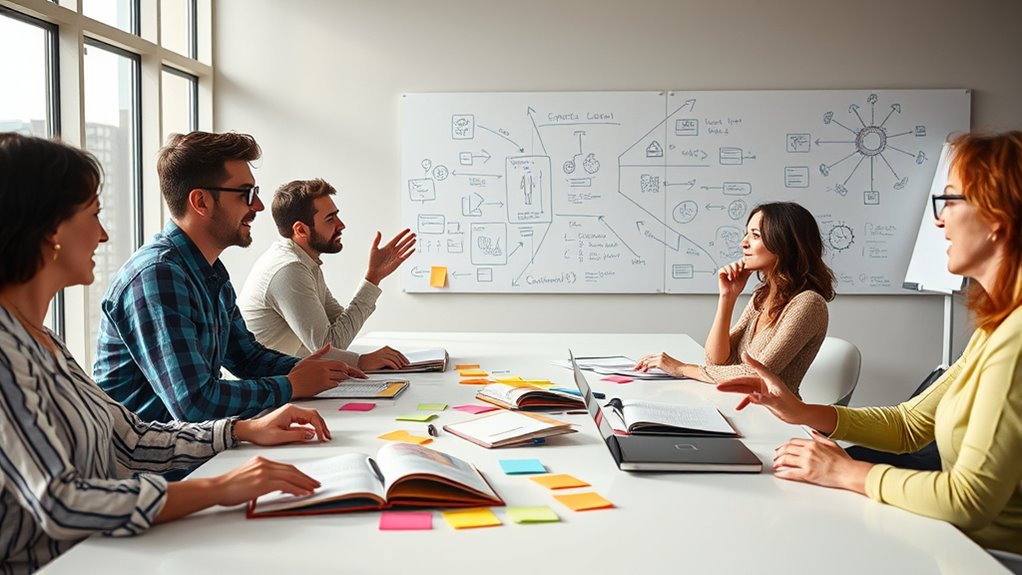“Yes, And” fuels creative momentum by encouraging you to accept ideas openly and build on them quickly, fostering rapid reframing. When you shift your mindset from criticism to acceptance, you open the door to innovative solutions and new possibilities. This approach promotes collaboration, reduces resistance, and accelerates problem-solving. By consistently practicing “Yes, And,” you can transform setbacks into opportunities and keep ideas flowing—continue exploring to discover how this mindset can revolutionize your creativity.
Key Takeaways
- “Yes, And” encourages building on ideas, fostering a collaborative environment that accelerates creative flow and momentum.
- Rapid reframing shifts perspectives, transforming challenges into opportunities for innovative solutions.
- Embracing acceptance reduces resistance, allowing teams to explore new possibilities without judgment.
- Consistent practice of “Yes, And” enhances idea expansion and keeps creative momentum sustained.
- This mindset promotes agility, enabling quick pivots and continuous innovation during brainstorming sessions.
Understanding the Core of “Yes, And

To truly grasp the essence of “Yes, And,” you need to recognize that it’s more than just a positive response—it’s a mindset that fosters collaboration and creativity. When you embrace this approach, you open your mind to new possibilities, encouraging others to share ideas freely. Practicing mindfulness meditation helps you stay present, making it easier to listen actively and respond thoughtfully. This awareness improves your ability to manage time effectively, ensuring you don’t dismiss ideas too quickly or get stuck on negatives. “Yes, And” isn’t about blindly agreeing; it’s about building on what’s given, creating momentum that propels projects forward. Developing mental clarity through practices like meditation can enhance your ability to respond constructively and foster a more innovative, open, and productive way to collaborate.
The Psychological Power Behind Acceptance and Expansion

When you accept your current situation, you build confidence that encourages you to take risks and try new things. Expanding your perspective opens the door to fresh ideas and creative solutions. Together, acceptance and expansion power your growth and resilience in any challenge you face. Incorporating color accuracy considerations can further enhance your creative projects by ensuring your visuals are precise and compelling.
Acceptance Sparks Confidence
Acceptance acts as a catalyst for confidence by shifting your mindset from resistance to openness. When you embrace ideas without immediate judgment, you create space for genuine mindset shifts. This openness enhances your belief in your ability to adapt and grow, fueling confidence. As you accept different perspectives, you foster idea synergy—where diverse thoughts combine to spark innovation. Instead of feeling overwhelmed or defensive, you see challenges as opportunities to learn and expand. This mental shift reduces self-doubt and cultivates a sense of control. By practicing acceptance, you reinforce a positive feedback loop: confidence grows as you consistently choose openness over resistance. Over time, this mindset becomes ingrained, making you more resilient and enthusiastic to explore new creative possibilities. Cultivating attention during your creative practice further amplifies this effect, enabling deeper engagement and more meaningful insights.
Expansion Boosts Creativity
Expanding your mindset opens the door to greater creativity by allowing new ideas to flourish. When you make a mindset shift from limiting beliefs to growth-oriented thinking, you create space for idea amplification. This openness encourages you to explore possibilities without self-judgment, fueling innovative thinking. By embracing expansion, you actively invite diverse perspectives and unconventional solutions, boosting your creative momentum. The more receptive you are to new concepts, the easier it becomes to connect ideas in novel ways. This psychological power behind acceptance transforms your approach, helping you see opportunities where others see barriers. Cultivating variety of materials can also inspire fresh ideas and approaches, further enhancing your creative flow. Ultimately, expansion isn’t just about thinking bigger—it’s about cultivating a fertile environment where your creativity can thrive and evolve naturally.
Enhancing Team Collaboration Through Receptive Mindsets

When you foster open communication, your team feels more comfortable sharing ideas and concerns. Building trust through openness encourages collaboration and innovation. By embracing receptive mindsets, you create an environment where everyone’s input is valued and respected. Incorporating analytical thinking into your team’s approach can further enhance problem-solving and idea generation.
Cultivating Open Communication
Fostering open communication begins with cultivating a receptive mindset that encourages team members to share ideas honestly and listen actively. Emotional intelligence plays a crucial role here, helping you recognize and manage your feelings while understanding others’ perspectives. When team members feel heard and valued, they’re more likely to contribute openly. This approach also supports effective conflict resolution, allowing disagreements to be addressed constructively rather than defensively. By promoting transparency and empathy, you create a safe environment where everyone feels comfortable speaking up. Open communication isn’t just about talking; it’s about truly listening and responding with understanding. Recognizing the importance of positive communication habits can further enhance team dynamics. When you foster this culture, collaboration improves, ideas flow freely, and your team becomes more agile and innovative.
Building Trust Through Openness
Building trust through openness is essential for strengthening team collaboration, as it creates a foundation where everyone feels safe to share ideas and concerns. Trust building begins with openness development, encouraging transparency and vulnerability. When you foster an environment where team members can express themselves without fear of judgment, you promote honest communication and mutual respect. This openness helps break down barriers, making collaboration smoother and more effective. By actively listening and showing genuine interest, you demonstrate that everyone’s input matters. Consistently practicing openness develops trust, which in turn boosts confidence and engagement within the team. Ultimately, embracing openness creates a culture where innovation thrives, and collective momentum propels your team forward. Engaging in trustworthy, reader-focused content fosters an environment of reliability and shared understanding that further enhances collaboration.
Transforming Challenges Into Opportunities With Rapid Reframing

Transforming challenges into opportunities requires a mindset shift that emphasizes agility and perspective. When you adopt this approach, you open the door to new possibilities by reframing obstacles as chances for growth. Mindset shifts are key—by viewing setbacks as learning moments, you foster idea synergy, where ideas build upon each other to create innovative solutions. Rapid reframing helps you stay flexible, enabling you to pivot quickly instead of feeling stuck. This approach encourages you to ask new questions and see problems through a different lens, turning hurdles into stepping stones. Additionally, integrating home decor ideas such as versatile wall organization systems can serve as metaphors for adaptable thinking. As a result, you cultivate resilience and unlatch creative momentum, making challenges less intimidating and more opportunities for breakthrough ideas.
Practical Ways to Incorporate “Yes, And” in Daily Workflows

Integrating “Yes, And” into your daily workflows can substantially boost collaboration and innovation. Start by adopting mindset shifts that emphasize openness and acceptance of others’ ideas. During meetings or brainstorming sessions, consciously respond with “Yes, And” to build on colleagues’ suggestions rather than dismissing them. This approach encourages idea expansion, transforming simple concepts into innovative solutions. Practice active listening, then frame your responses to acknowledge contributions while adding new perspectives. Incorporate “Yes, And” into your communication habits, whether in emails, project planning, or team discussions. Additionally, exploring diverse tools like portable camping gear can inspire creative thinking in unconventional contexts. Over time, these small shifts create a culture of collaborative energy, making it easier to generate and develop ideas rapidly. Consistently applying this mindset helps embed “Yes, And” as a natural part of your workflow.
Breaking Down Barriers to Creativity With Incremental Building
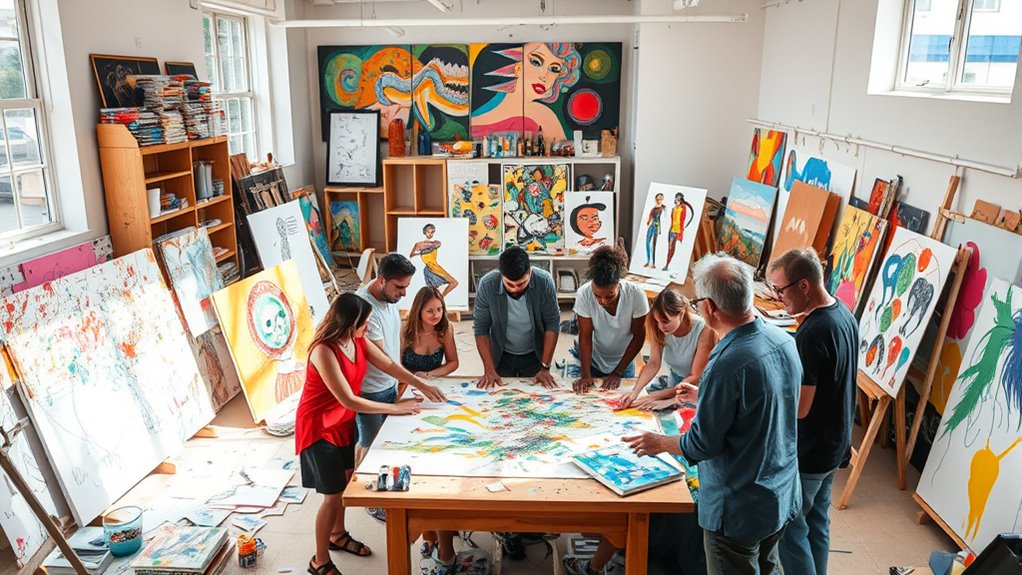
By focusing on small wins, you can steadily build confidence and momentum in your creative process. Adopting a growth mindset helps you see setbacks as opportunities to improve rather than obstacles. Together, these approaches remove barriers and make innovation feel more achievable. Recognizing the importance of small mistakes highlights how even minor errors can be turned into learning opportunities that propel your progress forward.
Embrace Small Wins
Breaking down a big creative goal into small, manageable wins can considerably boost your confidence and momentum. These small successes encourage mindset shifts, helping you see progress rather than overwhelm. When you focus on achievable tasks, you create consistent innovation catalysts—moments that inspire further effort and ideas. Embracing small wins makes creativity feel less intimidating and more sustainable, reinforcing your belief in your abilities. Each step forward, no matter how minor, builds momentum and keeps you engaged. This incremental approach allows you to celebrate progress regularly, fueling motivation and reducing fear of failure. Over time, these tiny victories compound, transforming your mindset and making larger, more complex goals approachable. Small wins aren’t just milestones—they’re the fuel that keeps your creative momentum alive.
Cultivate Growth Mindset
When you adopt a growth mindset, you start to see challenges as opportunities to learn rather than obstacles that block your progress. Self-reflection helps you identify limiting beliefs and areas for improvement, fueling your development. By viewing setbacks as part of the learning process, you build emotional resilience, which keeps you motivated and adaptable. Incremental building allows you to focus on small, manageable steps, making growth feel achievable. This mindset encourages curiosity and persistence, helping you break down barriers to creativity. As you celebrate progress, you reinforce a positive cycle of continuous improvement. Ultimately, cultivating a growth mindset transforms setbacks into fuel for innovation, empowering you to experiment boldly and expand your creative potential.
Case Studies: Success Stories of “Yes, And” in Action
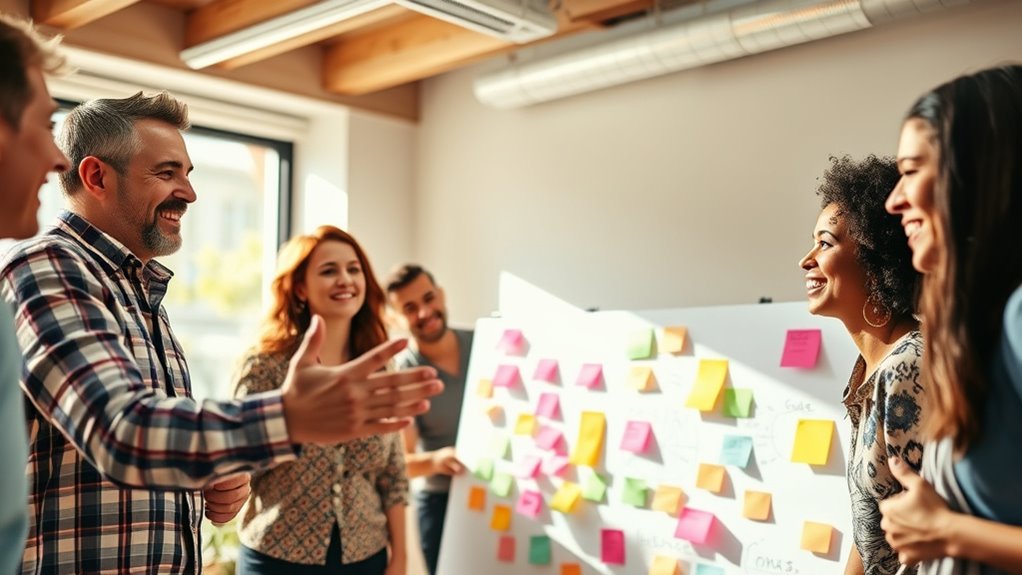
Real-world examples vividly demonstrate how embracing the “Yes, And” mindset can transform interactions and outcomes. In collaborative settings, teams practicing “Yes, And” experience mindset shifts that lead to idea proliferation. For instance, a startup founder used this approach to foster innovation, encouraging team members to build on each other’s ideas without judgment. This openness created a ripple effect, generating new concepts rapidly and improving overall creativity. Similarly, a creative agency adopted “Yes, And,” resulting in a more dynamic brainstorming process where ideas flowed freely, sparking groundbreaking campaigns. These success stories highlight how adopting this mindset fuels momentum and access collective potential, turning simple conversations into powerful engines for innovation and growth.
Overcoming Common Obstacles When Applying the Principle
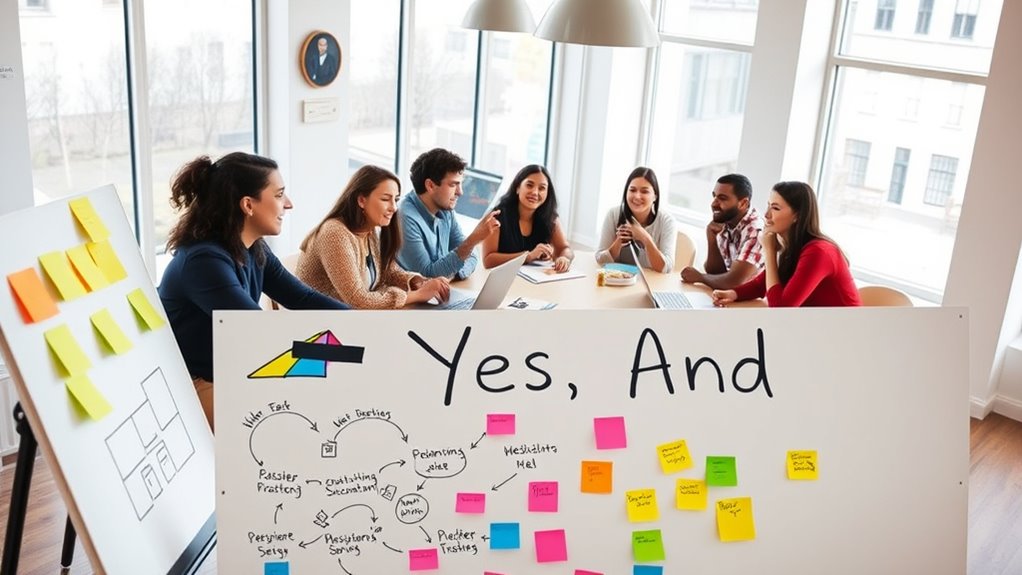
Applying the “Yes, And” principle can be challenging because it requires shifting mindsets and unlearning habits rooted in criticism or limitation. You might find it difficult to move past your default reactions, especially when faced with setbacks or conflicting ideas. To navigate these obstacles, focus on mindset shifts that emphasize openness and curiosity. Recognize the tendency to shut down ideas early and intentionally choose to see possibilities instead. Obstacle navigation involves staying present, avoiding judgment, and reframing negative thoughts. Remember, setbacks are opportunities to practice and strengthen your “Yes, And” skills. With consistent effort, you’ll find it easier to embrace collaboration, fuel creative momentum, and push past barriers that once seemed insurmountable.
Cultivating a Culture of Continuous Innovation
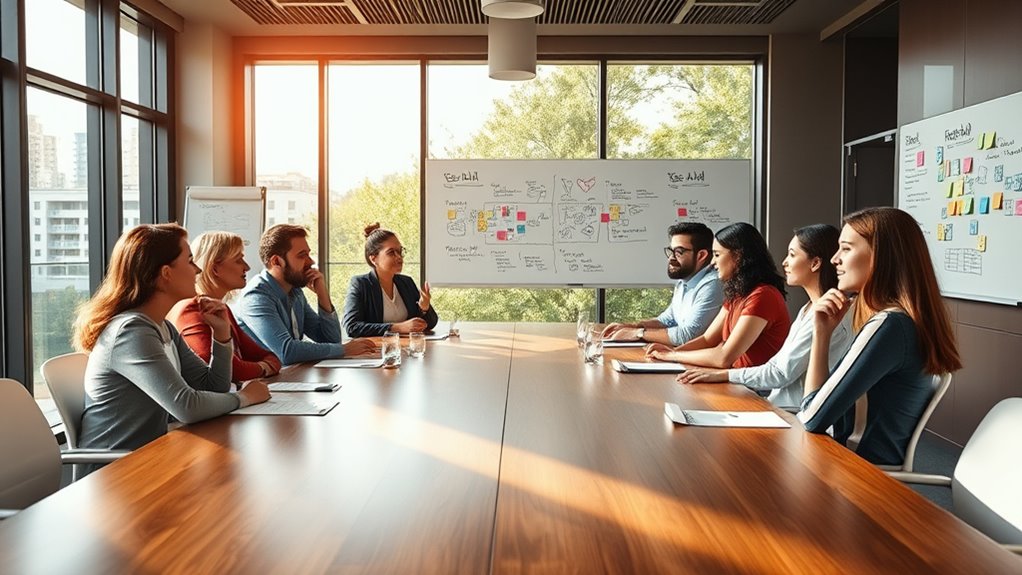
Creating a culture of continuous innovation requires intentional effort to embed openness and experimentation into your organization’s daily practices. You need mindset shifts that encourage team members to see failure as a learning opportunity and value idea expansion. Foster an environment where everyone feels safe sharing new concepts without fear of judgment. Promote regular brainstorming sessions, cross-functional collaboration, and feedback loops that support ongoing improvement. When you prioritize curiosity and adaptability, innovation becomes part of your daily rhythm. Encourage questions, challenge assumptions, and celebrate creative efforts—big or small. By consistently reinforcing these behaviors, you’ll cultivate a mindset that fuels continuous innovation and empowers your team to generate fresh solutions consistently.
Measuring the Impact of “Yes, And” on Creative Outcomes

Building a culture of continuous innovation sets the stage for effective collaboration, and one powerful tool to foster this environment is the “Yes, And” technique. To measure its impact on creative outcomes, you need to look beyond surface results and consider neuroscience insights that reveal how this approach enhances brain activity associated with openness and idea generation. Cultural influences also shape how individuals respond to “Yes, And,” affecting the degree of engagement and innovation. By tracking metrics like idea quantity, quality, and team cohesion, you can assess progress objectively. Combining behavioral data with insights into neural responses helps you understand how “Yes, And” fuels creative momentum, enabling you to refine practices and amplify its positive effects across your organization.
Frequently Asked Questions
How Can “Yes, And” Be Adapted for Remote or Virtual Teams?
In virtual collaboration, you can adapt “yes, and” by encouraging team members to build on each other’s ideas through digital tools like chat, video calls, or shared documents. Promote a culture of openness where everyone feels comfortable contributing. This digital adaptation keeps creative momentum alive, fostering a collaborative environment where ideas grow organically, even remotely. By actively listening and responding positively, you boost engagement and innovation across your virtual team.
What Are Common Mistakes to Avoid When Implementing “Yes, And”?
While exploring “yes, and,” you might stumble into common pitfalls like overuse mistakes that stifle spontaneity. Be cautious of turning every idea into agreement, which can dilute authenticity and creativity. Avoid overloading conversations with “yes, and,” as it may hinder genuine collaboration. Instead, balance enthusiasm with constructive critique. Recognizing these pitfalls helps you foster a supportive, innovative environment without falling into the trap of overdoing it.
How Does “Yes, And” Influence Leadership and Decision-Making?
You’ll find that “yes, and” fosters a collaborative mindset, encouraging open communication and idea sharing. It influences leadership and decision-making by creating decision synergy, where diverse perspectives come together to build stronger solutions. By embracing “yes, and,” you empower your team to contribute confidently, leading to more innovative outcomes and a culture of trust. This approach helps you navigate challenges with flexibility and collective strength, making decisions more effective and inclusive.
Can “Yes, And” Help in Resolving Conflicts Within Teams?
You can use “yes, and” to enhance collaborative communication and resolve conflicts within teams. By accepting others’ ideas and building on them, you foster understanding and reduce defensiveness. This approach encourages open dialogue, making conflict resolution more constructive. When you practice “yes, and,” you create a positive environment where team members feel heard, leading to quicker resolution and stronger collaboration.
What Training Methods Best Reinforce “Yes, And” Practices?
Ever wondered how you can best reinforce “yes, and” practices? Interactive workshops are highly effective because they engage participants actively, encouraging real-time application. Role-playing exercises put these principles into practice, helping team members internalize the mindset. Don’t you want to foster a culture of collaboration? Combining these methods guarantees your team practices “yes, and” consistently, boosting creativity and communication in everyday interactions.
Conclusion
Imagine your ideas as seeds planted in fertile soil, each “yes, and” watering them to grow into towering trees of innovation. When you embrace acceptance and expansion, you nurture a vibrant forest of creativity around you. Keep cultivating this mindset daily, and watch as your team’s momentum blossoms into a lush landscape of endless possibilities. Together, you’ll transform challenges into thriving forests of opportunity, fueling continuous growth and breakthrough ideas.
